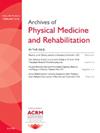Coding, Tracking and Trending Injury Data to Improve Practice and Safety for Caregivers and Their Patients 1145
IF 3.6
2区 医学
Q1 REHABILITATION
Archives of physical medicine and rehabilitation
Pub Date : 2025-04-01
DOI:10.1016/j.apmr.2025.01.050
引用次数: 0
Abstract
Objectives
(1) To describe how an employee injury coding project led to improved safety for caregivers and patients throughout a large hospital system. (2) To accurately investigate the underlying causes of employee injuries in order to implement effective injury prevention action plans including for rehabilitation units. (3) To understand the link between employee injury data, patient outcomes/NDNQI data and safe patient handling and mobility (SPHM) programs.
Design
Developed an injury coding system in order to accurately track data for 11 hospitals using over 15 years of workers’ compensation data. Accurate data led to implementing effective plans based on each category of cause of injury. Effective action plans led to significant decreases in frequency and severity of injuries, positive trending and sustainable programs. In addition to impacting caregiver safety, patient outcomes (eg, falls, pressure injuries) were positively impacted by improved mobility practices.
Setting
Acute care/hospital settings both rural and large urban hospitals with impact on associated outpatient/ambulatory care settings.
Participants
Employee injury data from 11 hospitals collected over a period of 15 years.
Interventions
Use of accurate coding of injuries to allow for accurate tracking of causes, and implementing injury prevention programs, including SPHM practices that also focused on patient initiatives and outcomes (eg, falls, pressure injuries).
Main Outcome Measures
Decrease in frequency and severity of caregiver injuries associated with unit-specific and cause-specific SPHM interventions.
Results
(1) Accurate coding and tracking of employee injuries led to (2) focused action plans and (3) implementing effective injury prevention programs and practices, which led to (4) significant and sustainable decreases in both frequency and severity of employee injuries and (5) improved patient outcomes through early and often mobilization using SPHM practices.
Conclusions
Obtaining enough information to accurately code and track the underlying causes of employee injuries leads to improved practice and safety for both caregivers and patients. More research is needed directly linking SPHM practices to improved patient outcomes.
Disclosures
Teresa Boynton worked for Banner Health for 26+ years as the Ergonomics and Injury Prevention Specialist, and Safe Patient Handling and Mobility lead. She developed the Banner Bedside Mobility Assessment Tool linked to SPHM practices. She then worked for Hill-Rom as a Clinical Consultant and developed Banner Bedside Mobility Assessment Tool 2.0. She worked with hospital systems to implement SPHM practices that are unit-specific focused on caregiver and patient safety and avoiding complications of immobility and the negative effects of bedrest. She is currently an independent clinical consultant focused on these same issues.
编码,跟踪和趋势伤害数据,以改善护理人员及其患者的实践和安全[145]
目标(1)描述员工伤害编码项目如何改善整个大型医院系统中护理人员和患者的安全。(2)准确调查员工受伤的根本原因,以便实施有效的伤害预防行动计划,包括康复单位。(3)了解员工伤害数据、患者结果/NDNQI数据和患者安全处理和移动(SPHM)计划之间的联系。设计开发伤害编码系统,以便使用超过15年的工人赔偿数据准确跟踪11家医院的数据。准确的数据导致基于每一类伤害原因实施有效的计划。有效的行动计划导致伤害频率和严重程度的显著降低,积极的趋势和可持续的计划。除了影响护理人员的安全外,患者的预后(如跌倒、压伤)也受到改善的活动实践的积极影响。农村和大型城市医院的急性护理/医院环境对相关门诊/门诊护理环境的影响。参与者从11家医院收集了15年的员工受伤数据。干预措施:对伤害进行准确编码,以便准确跟踪原因,并实施伤害预防计划,包括SPHM实践,该实践也关注患者的主动性和结果(例如跌倒、压伤)。结果:(1)员工伤害的准确编码和跟踪导致了(2)有针对性的行动计划和(3)实施有效的伤害预防计划和实践;这导致了(4)显著和可持续地减少了员工受伤的频率和严重程度;(5)通过早期和经常使用SPHM实践的动员,改善了患者的预后。结论获得足够的信息来准确地编码和跟踪员工伤害的潜在原因,可以改善护理人员和患者的实践和安全。需要更多的研究直接将SPHM实践与改善患者预后联系起来。esa Boynton在Banner Health工作了26年以上,担任人体工程学和伤害预防专家,以及安全患者处理和移动主管。她开发了与SPHM实践相关的Banner床边移动评估工具。随后,她在Hill-Rom担任临床顾问,并开发了Banner床边活动评估工具2.0。她与医院系统合作,实施针对护理人员和患者安全的SPHM实践,并避免不活动并发症和卧床不起的负面影响。她目前是一名专注于这些问题的独立临床顾问。
本文章由计算机程序翻译,如有差异,请以英文原文为准。
求助全文
约1分钟内获得全文
求助全文
来源期刊
CiteScore
6.20
自引率
4.70%
发文量
495
审稿时长
38 days
期刊介绍:
The Archives of Physical Medicine and Rehabilitation publishes original, peer-reviewed research and clinical reports on important trends and developments in physical medicine and rehabilitation and related fields. This international journal brings researchers and clinicians authoritative information on the therapeutic utilization of physical, behavioral and pharmaceutical agents in providing comprehensive care for individuals with chronic illness and disabilities.
Archives began publication in 1920, publishes monthly, and is the official journal of the American Congress of Rehabilitation Medicine. Its papers are cited more often than any other rehabilitation journal.

 求助内容:
求助内容: 应助结果提醒方式:
应助结果提醒方式:


